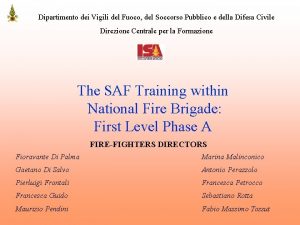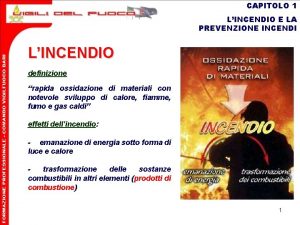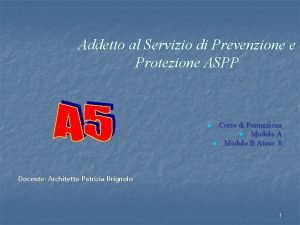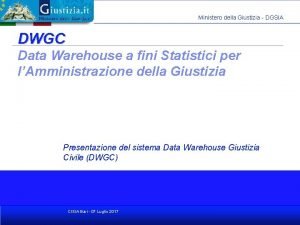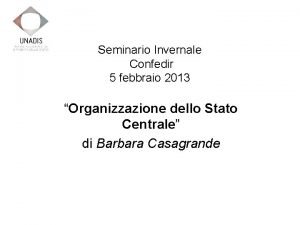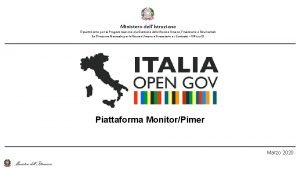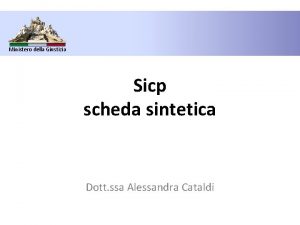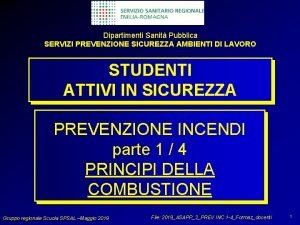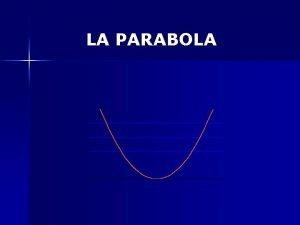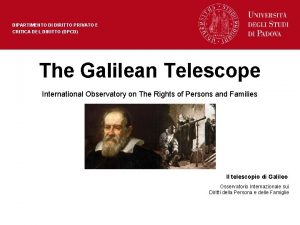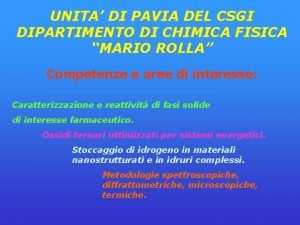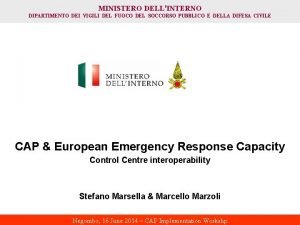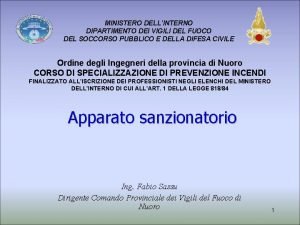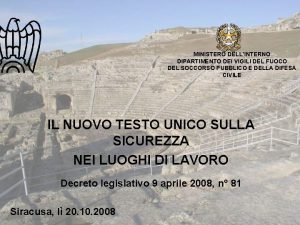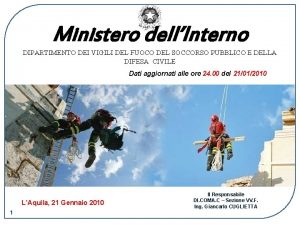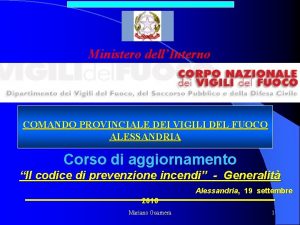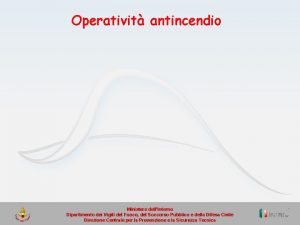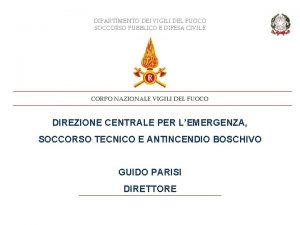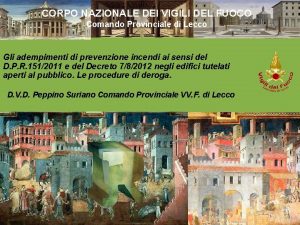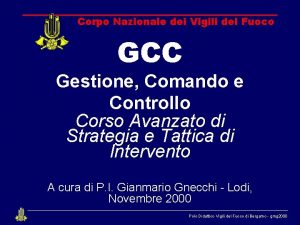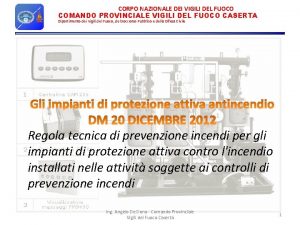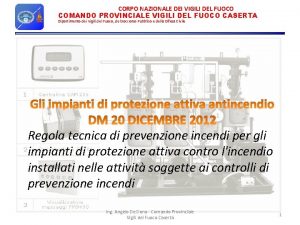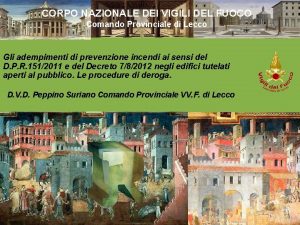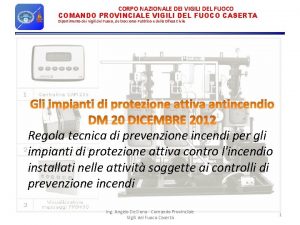MINISTERO DELLINTERNO DIPARTIMENTO DEI VIGILI DEL FUOCO DEL










![CFAST NUMERICAL RUNS HRR [=] MW t 0 Run 1: sensitivity analysis on the CFAST NUMERICAL RUNS HRR [=] MW t 0 Run 1: sensitivity analysis on the](https://slidetodoc.com/presentation_image_h2/4eeac77fc79e4e66bf945407f16c5e53/image-11.jpg)












- Slides: 23

MINISTERO DELL’INTERNO DIPARTIMENTO DEI VIGILI DEL FUOCO, DEL SOCCORSO PUBBLICO E DELLA DIFESA CIVILE DIREZIONE CENTRALE PER LA FORMAZIONE An Application In Fire Safety Engineering C. Barbera, A. Bascià, G. Di Salvo, A. Galfo, R. Lala, S. Lucidi, D. Maisano, G. Mancini, V. Puccia, F. Vorraro I e II Corso Direttori Antincendi Istituto Superiore Antincendi Roma Fire Service College Moreton-in-Marsh

FIRE SAFETY Deterministic Approach Laws and regulations Fire Engineering Approach Fire Models FIRE ENGINEERING APPLICATIONS • In absence of specific laws and regulations • When specific laws and regulations can’t be complied with • Fire investigation • High risk activities (safety report)

FIRE ENGINEERING: OPERATIVE VS. NUMERICAL MODELS Fitted parameters models (or operative models or zone models) • They solve exactly a set of simplified semi – empirical equations (momentum, energy, mass) • The computational domain is divided into mixed zones, where intensive properties (i. e. , P, T, concentrations) are assumed to be homogeneous • They yield temperature and gases and smoke concentration in each zone Distributed parameters models (or numerical models or field models) • They solve numerically (i. e. , approximately) a set of exact balance equations (momentum, energy, mass) • The computational domain is meshed by means of a calculation grid, whose refinement affects the accuracy of the result • They yield temperature and concentration profiles as a function of time and space

AN OPERATIVE MODEL: CFAST Hypotheses • Confined fires • Two mixed volumes: upper layer (hot layer) + lower layer (cold layer) ventilation controlled fire • tcomb << t = V / Q Controlling parameters • Ø S: stoichiometric ratio air / fuel Ø m: specific combustion rate [=] kg m-2 s-1 equivalence factor Ø A: compartment section [=] m-2 Ø me: air mass flow rate [=] kg s-1 • Ventilation factor, • Heat Release Rate (HRR) Correlation equation Ø X: output variable Ø X 0 : X evaluated in unconfined fires Ø a, b, z: correlation parameters

AN OPERATIVE MODEL: CFAST Equations mass equation pressure equation energy equation volume equation density equation temperature equation

AN OPERATIVE MODEL: CFAST Inputs • Geometry (compartment dimension, ventilation surface, etc. ) • Material properties (thermal conductivities, etc. ) • Fire geometry and position • HRR vs. time curve Outputs • Average temperature in both layers • height of layer interfacies • O 2 concentration • CO concentration • visibility index • mass and enthalpy exchange rates

A NUMERICAL MODEL: FDS (Fire Dynamics Simulator) Hypotheses • Both confined and unconfined fires • Rate of Heat Release (HRR) not depending on O 2 concentration Equations • • • Mass conservation Momentum conservation (three scalar equations) Constitutive law (nine scalar equations) Energy conservation Chemical species conservation

A NUMERICAL MODEL: FDS (Fire Dynamics Simulator) Inputs • Geometry (compartment dimension, ventilation surface, etc. ) • Material properties (thermal conductivities, etc. ) • Position and characteristics of ignition sources • Rate of Heat Release (HRR): depends on fuel and combustion conditions Outputs • Pressure, temperature, velocity and chemical species concentrations as a function of time and space • Fluxes and exchange rates

COMPUTATIONAL DOMAIN (D. M. 16/2/1982 All. I – act. 87) Plan Cross Section North View South View

COMPUTATIONAL DOMAIN (D. M. 16/2/1982 All. I – act. 87) • Geometry Two compartments Ventilation surfaces (2 windows + 1 external door + 1 internal door) • Material properties Concrete walls (r = 2100 kg m-3; cp = 0. 88 k. J kg-1 K-1; k. T = 1 W m-1 K-1) • Fire geometry and position 7 cellulosic material stacks • Heat Release Rate (HRR): depends on fuel and combustion conditions
![CFAST NUMERICAL RUNS HRR MW t 0 Run 1 sensitivity analysis on the CFAST NUMERICAL RUNS HRR [=] MW t 0 Run 1: sensitivity analysis on the](https://slidetodoc.com/presentation_image_h2/4eeac77fc79e4e66bf945407f16c5e53/image-11.jpg)
CFAST NUMERICAL RUNS HRR [=] MW t 0 Run 1: sensitivity analysis on the role of a t 1 t 2 t [=] s t 3 Runs a 1 0. 0029 k. W s-2 a 2 0. 0049 k. W s-2 a 3 0. 0069 k. W s-2 a 4 0. 009 k. W s-2 a 5 0. 011 k. W s-2 a 6 0. 02 k. W s-2 HRRmax (MW) 27. 55 32. 83 36. 90 40. 22 42. 97 52. 39 t 0 (s) 0 0 0 t 1 (s) 3080 2585 2300 2110 1975 1620 t 2 (s) 9240 7755 6900 6330 5925 4860 t 3 (s) 12320 10340 9200 8440 7900 6480

A TYPICAL CFAST OUTPUT WINDOW Profiles Values

a = 0. 0069 k. W s-2 a = 0. 009 k. W s-2 a = 0. 011 k. W s-2 a = 0. 02 k. W s-2

OUTPUTS OF CFAST RUN 1 Run 1 a 1 0. 0029 k. W s-2 a 2 0. 0049 k. W s-2 a 3 0. 0069 k. W s-2 a 4 0. 009 k. W s-2 a 5 0. 011 k. W s-2 a 6 0. 02 k. W s-2 h 1 (m) 1. 21 h 2 (m) 0. 89 0. 88 0. 87 0. 86 Tu 1 (°C) 670 654 643 636 630 610 Tl 1 (°C) 585 567 554 546 538 514 Tu 2 (°C) 289 282 278 275 272 265 Tl 2 (°C) 61 60 59 59 58. 7 58 Ø h 1: interfacies height in compartment 1 Ø h 2: interfacies height in compartment 2 Ø Tu 1: maximum temperature in the upper layer in compartment 1 Ø Tl 1: maximum temperature in the lower layer in compartment 1 Ø Tu 2: maximum temperature in the upper layer in compartment 2 Ø Tl 2: maximum temperature in the lower layer in compartment 2

CFAST NUMERICAL RUNS Run 2: sensitivity analysis on the role of ventilation factor

OUTPUTS OF CFAST RUN 2 Run 2 (a 6 = 0. 02) Vf 1 0. 031 Vf 2 0. 034 Vf 3 0. 0366 Vf 4 0. 046 t 600 (min) 77. 8 56. 2 46. 3 28. 1 h 1 (m) 1. 21 1. 22 1. 27 h 2 (m) 0. 86 0. 92 0. 99 1. 11 Tu 1 (°C) 610 665 704 813 Tl 1 (°C) 514 564 596 707 Tu 2 (°C) 265 271 273 282 Tl 2 (°C) 58 54 50 44 Ø t 600: t corresponding to Tu = 600 °C

FDS NUMERICAL RUNS Operative assumptions Distributed parameters model Fire load can be splitted! 7 stacks with HRR = HRRmax / 7 Fire starts from stack 1 Each stack burns when T ≥ 200°C (ignition temperature) Run 1: without sprinklers Run 2: with sprinklers

OUTPUTS OF FDS RUN 1 Ceiling temperature vs. time t (T 1 max) = 338 s Ceiling temperature distribution at t = 338 s

OUTPUTS OF FDS RUN 1 Smoke propagation: even though at t = 180 s only one stack burns, smoke invades both the compartments.

FDS NUMERICAL RUN 2 Sprinklers lay-out Sprinklers characteristics • Operating pressure: 0. 483 bar • K: 79 l min-1 bar -1/2 • Activation temperature: 74°C • RTI (Response Time Index): 110 (m·s)1/2

OUTPUTS OF FDS RUN 2 Ceiling temperature Synoptic Tc 1 Tc 4 Tc 7

OUTPUTS OF FDS RUN 2 Smoke propagation and sprinkler activation: the first sprinkler activates at t = 111. 6 s… … and the last one at t = 330 s

CONCLUSIONS… • Zone models are very sensitive to ventilation factor and HRR vs. time curve (controlling parameters): they are quick and simple • Field models allow a more realistic and flexible problem description: accurate input estimation is required and simulations are very time expensive • T vs. t curves yielded by the two models are different but similarly shaped … AND FURTHER INVESTIGATIONS • A set of numerical runs has to be carried out in order to gain a deeper insight in T vs. t curves • A comparison between model prediction and deterministic approach results can be performed
 Allievi vigili del fuoco
Allievi vigili del fuoco Sifead ministero del lavoro
Sifead ministero del lavoro Temperatura di infiammabilità
Temperatura di infiammabilità Triangolo del fuoco sicurezza
Triangolo del fuoco sicurezza Call center cittadinanza
Call center cittadinanza Ministero della giustizia
Ministero della giustizia Ministero della giustizia
Ministero della giustizia Pimer monitor 440
Pimer monitor 440 Alessandra cataldi ministero giustizia
Alessandra cataldi ministero giustizia Calliope giustizia
Calliope giustizia Tiap ministero giustizia
Tiap ministero giustizia Si fosse foco arderei il mondo testo
Si fosse foco arderei il mondo testo Autocatalisi fuoco
Autocatalisi fuoco Fuoco nella sera klee
Fuoco nella sera klee I poeti lavorano di notte parafrasi
I poeti lavorano di notte parafrasi Simmetria parabola
Simmetria parabola Dipartimento del tesoro
Dipartimento del tesoro Dipartimento del tesoro
Dipartimento del tesoro Dipartimento di diritto privato e critica del diritto
Dipartimento di diritto privato e critica del diritto Testo marcia dei diritti
Testo marcia dei diritti Quale sono i poligoni
Quale sono i poligoni Agnus dei qui tollis peccata mundi, miserere nobis
Agnus dei qui tollis peccata mundi, miserere nobis Dipartimento di chimica pavia
Dipartimento di chimica pavia Relazione finale coordinatore di dipartimento matematica
Relazione finale coordinatore di dipartimento matematica
